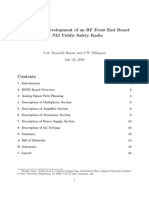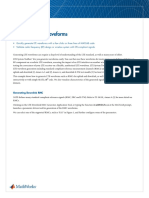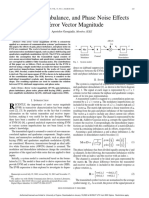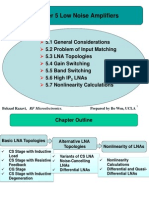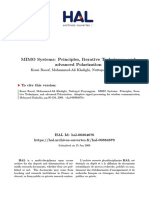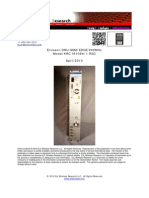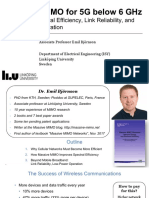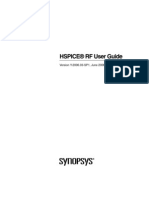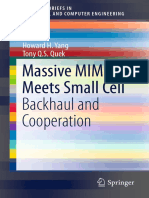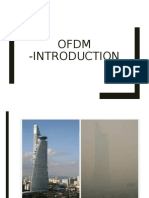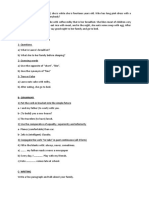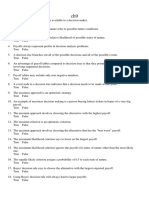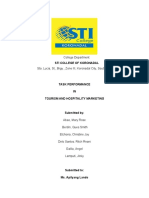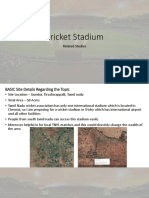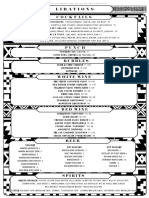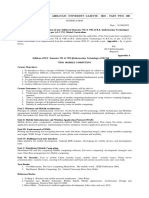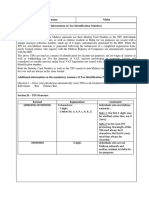RF-System Analysis
from system requirements to Rx/Tx specs
Outline
• Test environment of radio system specs
- Receiver analysis
- Transmitter analysis
• Distribution of specs over Rx blocks
• Summary
1
J.Dąbrowski, Intro to RF Front-End Design
Test environment of system specs
• Frequency bands /filtering
• Reference sensitivity /NF
• Blocking requirements /1dB point and DR
• Intermodulation requirements / IP3, IP2 and
LO phase noise
• Image rejection
• Transmitted power
• Out-of channel emission /filtering and LO
phase noise
• Spurious tones
2
J.Dąbrowski, Intro to RF Front-End Design
1
� Reference sensitivity
Digital
Baseband
Receiver Demodulator signal
Pin,min ADC
Front-End Part
SNRin SNRmin
sensitivity Pin,min
NF = SNRin – SNRmin
BERmax SNRmin = Pin,min– (-174dBm/Hz + 10logB) – SNRmin
For DECT std. Pin,min= -83dBm, B = 1.728 MHz
BERmax= 10-3 → SNRmin ≈ 10dB (also for N+I)
NF = -83 + 174 -10log(1.728×106)-10 ≈ 18dB Quite relaxed
But 3..4 dB would be sacrificed for loss in duplexer and RF filter
3
J.Dąbrowski, Intro to RF Front-End Design
BER versus SNR in demodulator
GFSK synchronous differential
demodulator in DECT
Ideal GFSK synchronous
demodulator (for AWGN)
10-3
SNR = Psig /N = (EbR)/(N0B)
SNR = Eb/N0 × R/B
R/B ≈ 0.5 … 1.5 (often)
R – bit rate
B – channel bandwidth
(R/B)DECT = 1152/1728 = -1.8 dB
SNRmin = (Eb/N0)dB + (R/B)dB = 12 -1.8 = 10.2 dB
4
J.Dąbrowski, Intro to RF Front-End Design
2
� Comment on CDMA receivers
BB signal after BB signal
BB signal Encoding Decoding received
spreading
f f f
BBB BSS BBB
For a given
demodulation
scheme
Processing gain:
GP = BSS /BBB SNRmin = (Eb/N0)dB + (R/B)dB ≈ (Eb/N0)dB - (GP)dB
≅ Rchip /Rdata
Example:
GP = SNRBB /SNRSS
For WCDMA GP = 10lg (3.84Mcps/12.2kbps) = 25dB
SNRmin = (Eb/N0)dB - (GP)dB = 7dB – 25dB = -18dB
QPSK
5
J.Dąbrowski, Intro to RF Front-End Design
Blocking requirements
• Desensitization
• Dynamic range
• Reciprocal mixing and LO
phase noise
• Band and channel filtering
6
J.Dąbrowski, Intro to RF Front-End Design
3
� Desensitization
for DECT
Co-channel
This IP3 of the RF part only,
after mixer inband blockers
3α A 2 (t ) AIP2 3 2
are suppressed
y (t ) = α 1 + 3 bl AS cos ω S t + ... >
2 Abl2 1 − σ
2
3 α 3 Abl2 2
α 1 −
(α )
1
2
>σ (σ < 1) IIP3 > Pbl + 10 log , Pbl max = −33dBm
2 1− σ
α1 σ
AIP2 3 = 1.33 Gain drop IIP3RF
α3
1dB 0.79 -20.4dBm
3dB 0.5 -24.7dBm
This is kind of AM that in GMSK
7
J.Dąbrowski, Intro to RF Front-End Design
1dB compression point and DR
G +Pin
1dB For 1dB drop the blocker is called
1dB compresion point P1dB
A12dB 0.145 α 1
P1dB = 10 log = 10 log
2 R0 2 R0 α 3
AIP2 3 1.33 α 1
Pin min P1dB IIP3 = 10 log = 10 log
Sensitivity 2 R0 2 R0 α 3
In-band interferers must not IIP3 − P1dB = 9.6dB But in practice
saturate the Rx might be different
IIP3 > −33 + 9.6 = −22.4dB First estimate
for Rx IP3
Pbl max = -33dBm and also Psig max = -33dBm
This DR refers to the whole Rx chain.
P1dB > -33dBm, DR = P1dB – Pin,min The blocker will be suppressed in BB
DR > -33 – (-83) = 50dB filter, but the max signal will not.
8
J.Dąbrowski, Intro to RF Front-End Design
4
� Comment on QAM systems
BER must be maintained in presence of any blocker
E.g. for any blocker BER=10-3 → SNRmin This is kind of AM can be removed
but we have Rx Noise + blocker noise in GMSK Rx by amplitude clipping
(AM at f0 and uncorrelated)
2
3α A 2 α1 Pbl2
PN bl = 3 bl ASig (2 R ), AIP2 3 = 1.33 PN bl = 4 Psig mW
2α 1 α3
0
PIP2 3
PN bl dB
(
= 2 Pbl dB
)
− IIP3 + Psig dB
+ 6dB
N P min
= N ref + NF = −174 + 10 log BW + NF
N P sig
= Psig − SNRmin N + PN bl = N
P min P sig
Inherent Rx noise
Rx noise + Noise induced
Allowed by blocker Psig − PN bl
noise for signal IIP3 = Pbl + + 3dB
during the test 2
It is the Rx total IIP3, since the noise induced by
blocker would not be suppressed by BB filter
9
J.Dąbrowski, Intro to RF Front-End Design
Reciprocal mixing and LO phase noise
Noisy interferer foff
at IF Sn(f ) Noise imposed:
fH
desired
Pn = ∫ S n ( f )df = S av B
Sav fL
Typically we require SIR >15dB
fL fH f
SIR = Psig - 10log SavB
LO Phase Noise = Psig - 10log Sav - 10logB
limits receiver
selectivity
L (foff ) = 10lg Sav - Pint
= Psig – Pint - SIR - 10logB
L (1.73MHz) = -73 + 58 - 15 - 10lg(1.73·106) = -93 dBc/Hz
L (3.46MHz) = -73 + 39 - 15 - 10lg(1.73·106) = -112 dBc/Hz
L (5.18MHz) = -73 + 33 - 15 - 10lg(1.73·106) = -118 dBc/Hz
10
J.Dąbrowski, Intro to RF Front-End Design
5
� Blocking requirements (cont’d)
Attenuation 10-3 BER must
required
be maintained
The Rx filters must suppress the blockers so that SNR = C/(N+I) = 10dB
Depending on Rx architecture we may have a few filters but at least the band-
select and IF filter. We need an effective attenuation of at least 65..70dB provided
by RF filter, LNA and BB filter
With an RF filter of 30..40dB we need another 30..40dB from LNA and BB
11
J.Dąbrowski, Intro to RF Front-End Design
Intermodulation requirements
Fundamental Output
3rd order IM ∆P
Psig,out
IIP3
IIP3 = ∆P/2 + Pin
Two-tone test For DECT 2 × (Pint= -46dBm) each, and Psig= -80dBm
and still BER=10 -3
→ but we have Noise + IM3 (uncorrelated)
N = -83dBm - SNRmin = -93dBm (input referred thermal noise)
How much IM distortions can we allow ? → SNRmin = C/(N+I ) = 10dB
12
J.Dąbrowski, Intro to RF Front-End Design
6
� Intermodulation requirements (cont’d)
(N + PIM3 )|dBm = Psig - SNRmin = -80dBm -10dB = -90dBm ( all input referred )
(N + PIM3 )|dBm - N |dBm = -90dBm + 93dBm = 3 dB
(N + PIM3 ) / N = 2 → PIM3 = N
Hence:
IIP3 = Pin + ∆P/2 ≈ - 46 + (-46+93)/2 = -22.5dBm (which is practically the same as obtained
before from the 1dB compression point )
However, in zero-IF the IP2, LF feedthrough in mixer,
and LO leakage would contribute as well.
LF feedthrough
HD2 at BB
RF LP
LNA ADC
Filter Filter
We focus on IP2 of mixer, LPF stops the
Leakage LO
interferers, and IP2 of LNA less critical
13
J.Dąbrowski, Intro to RF Front-End Design
IP3 and IP2 requirements
With this correction we have:
(N + PIM3 + PIM2)|dBm = Psig - SNRmin = -80dBm -10dB = -90dBm ( all input referred )
(N + PIM3 + PIM2)|dBm - N |dBm = -90dBm + 93dBm = 3 dB
(N + PIM3 + PIM2) / N = 2 → PIM3 + PIM2 = N We allow less PIM3 to keep N
α 2 mix (G RF Gmix )A 2
2
P3 G RF P 2
PIM 3 = int
, and PIM 2 = int
(2 R G ) =
0 RF
int
P 2
IP 3 2 4Gmix PIP 2 mix
P3 G RF P 2 1 1 G G
int
+ int
= N , and also ≈ + LNA + RF
PIP2 3 4Gmix PIP 2 mix PIP 3 PIP 3 LNA PIP 3 mix PIP 3 BB
Assume all blocks contribute equally to the total IP3 and PIP2 mix = β PIP3 mix
P3 GF P 2
int
+ int
= N , G F ≈ 0.5, P = 10 −4.6 mW
PIP2 3 12 β PIP 3 int
Gain of RF filter and duplexer
14
J.Dąbrowski, Intro to RF Front-End Design
7
� IP3 and IP2 requirements (cont’d)
Intermodulation requirements Single blocker requirements
β [dB] IIP3 [dBm] *) IIP3mix [dBm] Gain drop σ IIP3RF
10 -20.5 -0.8 1dB 0.79 -20.4dBm
15 -21.9 -2.1 3dB 0.5 -24.7dBm
20 -22.3 -2.5
How can we use the estimate for IP3RF ?
25 -22.4 -2.7
From 1dB point we also have IP3 > -22.4dBm
*) For GLNA = 15 dB
so we conclude that the impact of mixer IP2
Smaller β → IP2 of mixer has more must be small (e.g. β = 25dB or different
impact on total (N+I) → then larger balance between IP3 components is needed)
total IP3 required 1 1 G*
≈ + RF , GRF*
= σ GRF
PIP 3 PIP 3 RF PIP 3 BB
We see that the demands for the IIP3RF IIP3 = -22.4dBm
(-24.7dBm →3dB gain drop) are too 0.79GRF
10 2.24
≈ 10 2.04
+
relaxed. If we only allow 1dB: PIP 3 BB
For GRF = 15..20 dB we obtain practical GRF PIP 3 BB ≈ 151.8 → IIP3 BB ≅ GRF dB
− 22dB
values of IIP3BB = -7dBm … -2dBm
Large GRF is prohibitive
15
J.Dąbrowski, Intro to RF Front-End Design
Image rejection in Rx
• Homodyne (zero-IF) overcomes problems of heterodyne (esp.
image problem) but suffers from DC-offset, 1/f noise, LO
leakage, self-mixing, even order distortions and IQ mismatch.
For WCDMA systems DC band close to 0 can be sacrificed
• Low-IF overcomes DC-offset and 1/f noise but suffers from
close-image problem and even order distortions. Image-reject
mixer must be used like in zero-IF, but here the IQ
requirements are much tougher. BPF at IF must be used
(requires 2x more poles/zeros than LPF). For narrow-band
systems better than zero-IF.
Amplitude and phase mismatch in IQ paths
( Pim Psig ) out (∆ A A) 2 + θ 2
IRR = = In practice IQ IRR > -40dB but -60..-70dB
( Pim Psig ) in 4 are sometimes needed, so filters must help,
such as polyphase filters in low-IF
16
J.Dąbrowski, Intro to RF Front-End Design
8
� Required image rejection
for DECT
fLO for Low-IF Rx
IR = Pim in – (Psig – 15dB)
Low-IF Rx,
= -58 – (-73 -15) = 30dB
IR = -73 – (-73 -15) = 15dB zero-IF Rx, - More relaxed requirements
17
J.Dąbrowski, Intro to RF Front-End Design
Channel Filter and ADC
In-band blockers
suppressed Channel selection can be completed
in BB proc. but ADC must maintain
IF the blockers
× BPF/LPF ADC
Pbl –A(fbl) LPF for zero-IF
f0 GLPF
12 dB/oct / 2 ord
Usually, tradeoff between ADC DR 24 dB/oct / 4 ord
and filter order A6(∆fch ) 36 dB/oct / 6 ord
Attenuation ↔ (foffset, filter order)
DRADC = (Pbl – A) – (Pin min – 15dB)
∆fch /2 ∆fch 3∆fch /2 f
Pmax Quantization noise
Wanted Adjacent
/ input referred
channel for 0-IF channel
15 dB below sensitivity is a rule of
thumb if 10dB for SNR is required
18
J.Dąbrowski, Intro to RF Front-End Design
9
� Channel Filter and ADC (cont’d)
For DECT max signal = max blocker so LP Filter plays
different role → mainly band limitation (Nyquist criteria)
If fS high then the requirements for the filter relaxed ( minimum is 1.8 MHz )
We have: DRADC = Pin max – (Pin min– 15dB ) = -33 –(-83-15) = 65 dB
DRADC = 6.02N + 1.76dB → N = 11 bits and if this is too large we can use VGA
ctrl
BB
VGA LPF ADC
proc.
ADC quantization noise, fS
Pq = ( ∆2 /12)/(R0 p) ×1000 mW p – oversampling factor = 2fS /BW for zero-IF
= VFS2 2-2NBW / (24R0 fS) ×1000 mW, ∆ - ADC resolution = VFS 2-N
19
J.Dąbrowski, Intro to RF Front-End Design
ADC and Front-end gain
GFE Pin
SNRmin = Sensitivity and input reference noise
Pq + NFFE GFE N in
SNRmin Pq 10 Pq
GFE = =
Pin − NFFE SNRmin N in 10 −8.3 − NFFE 10 ⋅10 −11.1
NFFE < NFRx = 25 Very relaxed
10 Pq 10 Pq
so for practical value NFFE = 5 ⇒ GFE = = = 2.17 ⋅10 9 Pq
10 −8.3 − 5 ⋅10 ⋅10 −11.1 10 −8.3 − 5 ⋅10 ⋅10 −11.1
GFE dB
= Pq dBm
+ 93.4dB, and Pq dBm
= −6.02 N + 20 log VFS − 10 log f S Bw − 0.8dB
Take VFS = 1V , and f S Bw = 1 (oversampling = 2)
GFE dB
= −6.02 N + 92.6dB = 26.6dB when using N = 11bits
This are rather mild design requirements
20
J.Dąbrowski, Intro to RF Front-End Design
10
� Other specs of Rx / Noise floor
F dBm = N in dBm / Hz
+ 10 log Bw
RF RS VRS2
Amplifier
RF - + Nin
Filter
Rin
Noise from antenna like RS = Rin
resistor noise. If pointed Matching for power
at horizon Teq=290K
2
Rin 1
N in W = 4kTRS ×
Rin + RS
Hz
Rin
For DECT Bw=1728 kHz W W
N in = kT = 1.38 ⋅10 − 23 ⋅ 290 K = 4 ⋅10 − 21
F = −174 dBm / Hz + 10 log1.728 ⋅10 6
Rs = Rin K ⋅ Hz Hz
dBm
kT
= −174 + 62.4 = −111.6 dBm N in dBm / Hz = 10 log = ....
Rs = Rin 1mW
21
J.Dąbrowski, Intro to RF Front-End Design
Other specs of Rx / Spurious Free
Dynamic Range (SFDR)
Pin min = F + SNRmin ( Rx sensitivity ) Output
Pin max when PIM 3 = F + G ∆P
PIM3
2 ( IIP3 − F )
SFDR = Pin max − Pin min = − SNRmin
3
Pout fundamental
IM3 SFDR = 0.67(-22.4+111.6)-(10+18)
= 31.8 dB required for our DECT
PIM3= F+G
F+G
Max Pin is so that
PIM3 < noise floor
Pin,min Pin
F Pin,max IIP3 SFDR is a combined performance
SNRmin
measure of Rx for noise and linearity
22
J.Dąbrowski, Intro to RF Front-End Design
11
� Transmitter requirements
• Max power and emission mask
- noise
- spur tones
• Modulation quality
- SNR
- constellations and EVM/ BER
23
J.Dąbrowski, Intro to RF Front-End Design
Phase noise
Transmitted
Modulated signal
signal
IF RF
× BP
Filter
PA
Matching
& BP Filter
f0
Frequency
Synthesizer fRF
• Close-in phase noise reduces SNR
Close-in PN
• Far-away phase noise creates
Far-away PN spectral emission outside the
channel
• Harmonics must be avoided
f0 • PA provides spectral regrowth due to
its nonlinearities
24
J.Dąbrowski, Intro to RF Front-End Design
12
� Emission mask and PN
• Maximum output power 250mW (24 dBm)
• Maximum radiated power
Estimate of LO phase noise:
L (foff ) = 10log Soff - P0
= Moff -10log B - M0
M0
M1
L (1.73MHz) = -8 - 62 - 24 = -94dBc/Hz
L (3.46MHz) = -30 - 62 - 24 = -116dBc/Hz
M2 L (5.18MHz) = -44 - 62 - 24 = -130dBc/Hz
M3
foff More stringent than
Channel spacing for the receiver
25
J.Dąbrowski, Intro to RF Front-End Design
Distribution of specs over Rx blocks
LNA
RF LPF
ADC
Filter &VGA
I Q
Dupl
exer
LO
Transmitter
part
For each Rx block: Gi , NFi , IP3i
For LO: phase noise & spur tones
How do we distribute Rx specs over the blocks ?
26
J.Dąbrowski, Intro to RF Front-End Design
13
� Distribution of specs (cont’d)
NF2 − 1 NF3 − 1 If the blocks are not
NF = NF1 + + + ... impedance matched,
G1 G1G2
corrections needed
1 1 G GG
≈ + 1 + 1 2 + ...
IP3 IP31 IP32 IP33
G = G1 × G2 × G3 × ... Only approximate
formula for IP3
Observe that distribution of gain to maintain
low NF and high IP3 (or IP2) is contradictory.
Largest signal or a blocker must not saturate LNA, mixer or IF filter.
Often LNA requires gain control as well to avoid saturation of the following
stages. Using VGA before ADC is typical.
27
J.Dąbrowski, Intro to RF Front-End Design
Summary
• First order specs can be retrieved from system
requirements
• Simulation models needed for verification
• In case of integrated TRx’s the blocking and
intermodulation requirements are more stringent
than for Rx /leakage, substrate coupling, and
radiation of Tx power/ Digital part even more
noisy
• Distribution of specs depended on the available
RF blocks and architecture, many constraints,
little degree of freedom usually
28
J.Dąbrowski, Intro to RF Front-End Design
14

